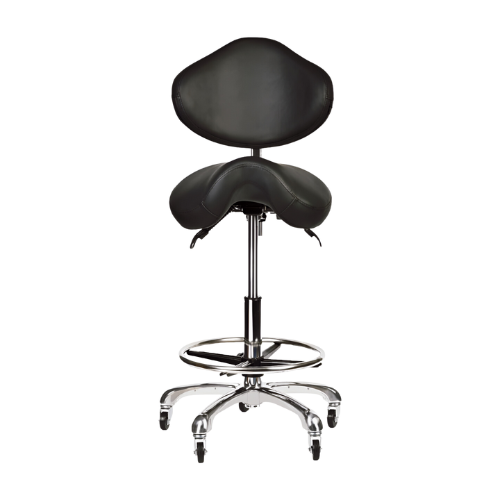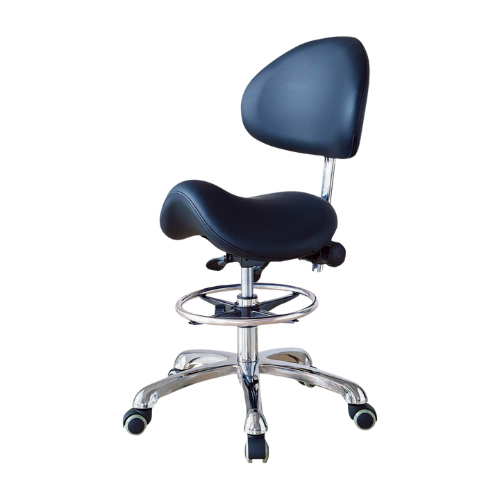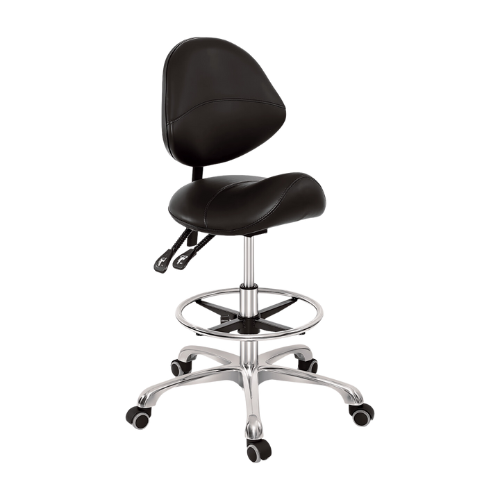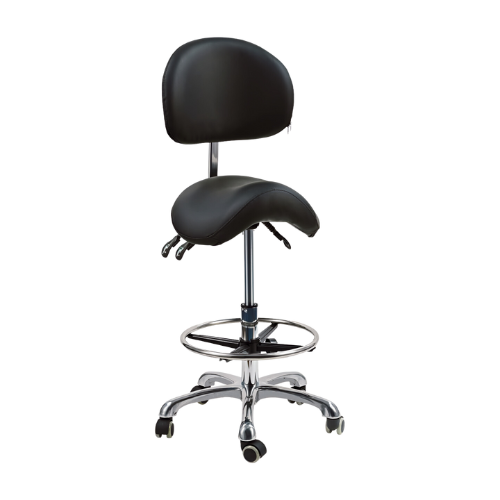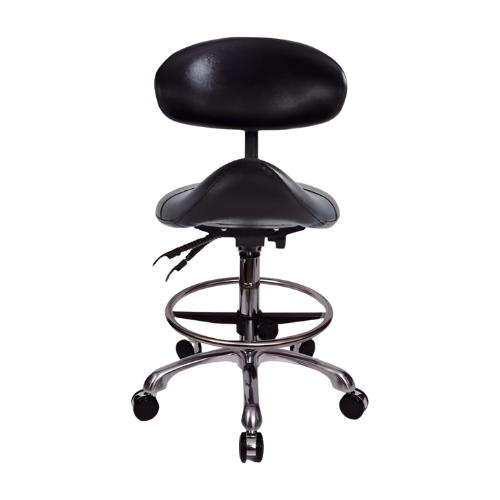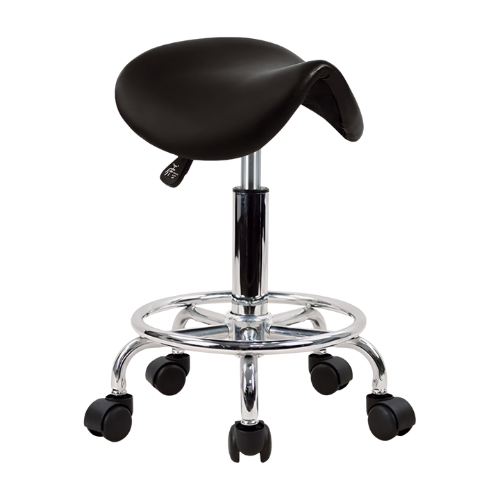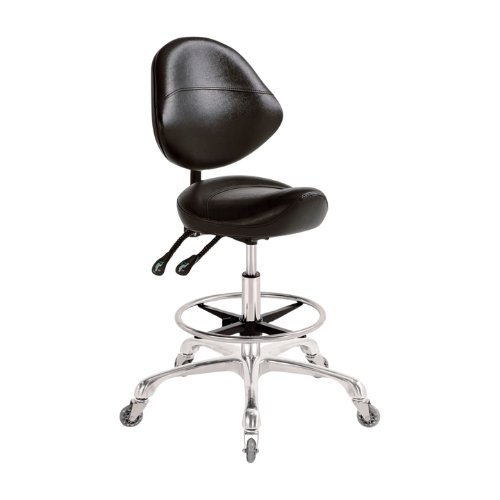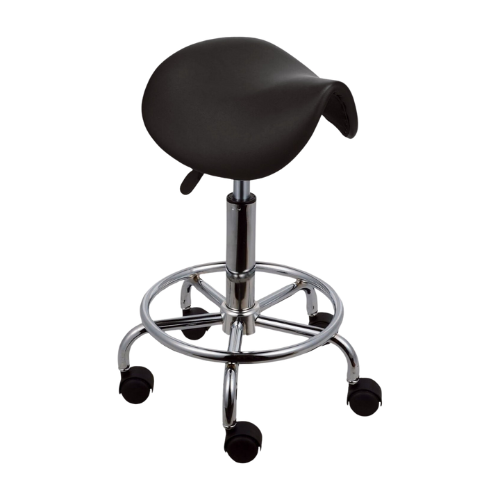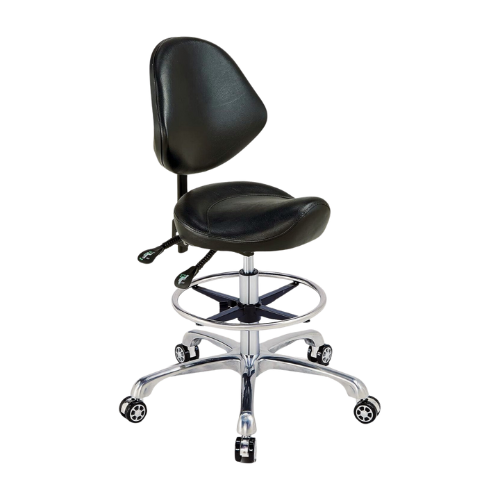Selecting the right dental chair is a pivotal decision for any dental practice. The unique combination of a saddle stool with a footrest offers a blend of comfort, ergonomics, and functionality that is indispensable in modern dental care.
Here are various aspects you need to consider before making this crucial investment, ensuring you choose a chair that meets your immediate needs and stands the test of time in your practice.
Ergonomics and Comfort
- Ergonomic Design: The saddle stool is uniquely designed to mimic the natural positioning of the human body when riding a horse. This design provides unparalleled ergonomic support, especially during prolonged dental procedures. The shape encourages natural spine alignment, reducing the risk of lower back pain, a common ailment among dental professionals.
- Height Adjustability: A crucial feature of the saddle stool dental chair is its height adjustability. This allows dental professionals of different statures to adjust the chair to their ideal height, ensuring comfort and reducing the risk of musculoskeletal disorders.
- Seat Padding: Comfort is key in a dental practice, not just for patients but also for practitioners. The seat padding is designed to offer optimal support during long procedures, ensuring the practitioner’s comfort.
- Movement and Reach: The design of enhances ease of movement and reach. This is essential in a dental setting where practitioners must maneuver easily around the patient and swiftly access various tools.
- Posture Support: Good posture is critical in dentistry. It promotes an upright posture, reducing the strain on the back, neck, and shoulders typically associated with prolonged sitting.
- Footrest Comfort: The footrest in these chairs is not just an afterthought; it’s a critical component for all-day comfort. An adjustable and comfortable footrest can significantly affect overall comfort and fatigue levels.
- Breathable Materials: Another important aspect is the materials’ breathability. Materials that allow for air circulation prevent overheating and discomfort, especially during longer procedures.
Durability and Quality
- Construction Materials: The materials used to construct are pivotal for durability. High-quality materials ensure the chair withstands the rigors of daily use in a busy dental practice.
- Suitability for Heavy-Duty Use: Assessing whether the stool is designed for heavy-duty use is essential, especially in high-volume dental practices.
- Lifespan and Durability: Understanding the stool’s expected lifespan and durability helps make a cost-effective choice. A durable chair represents a long-term investment in your practice’s efficiency and comfort.
- Warranty and Guarantees: Information about warranties or guarantees is crucial. These factors provide insight into the manufacturer’s confidence in their product and protect your investment.
- Resistance to Wear and Tear: A dental practice’s daily wear and tear can be significant. Evaluating the stool’s resistance to such conditions is necessary for a long-lasting investment.
- Cleaning and Disinfection: In a dental setting, the ability to clean and disinfect the chair easily is non-negotiable. A stool that can withstand frequent cleaning without deteriorating is essential for maintaining hygiene standards.
Design and Aesthetics
- Color Options: Having a variety of color options allows for customization to match the clinic’s décor, adding a personal touch to the workspace.
- Modern Design Compatibility: The stool’s design compatibility with modern dental offices is important for creating an aesthetically pleasing environment.
- Space Efficiency: Space efficiency is particularly crucial in smaller dental practices. A compact design that doesn’t compromise on functionality can be a game-changer.
- Mobility: The stool’s ease of movement around the office enhances workflow efficiency and adaptability, making it a versatile addition to any dental practice.
Adjustability and Customization
- Seat Size Options: Different dental professionals have varying body sizes, making the availability of different seat sizes crucial. Selecting the right size ensures maximum comfort and ergonomic benefits.
- Backrest Adjustability: A customizable backrest that allows for adjustments in height and tilt is vital for personalized comfort and spinal support. This feature can significantly reduce the risk of chronic back problems.
- Seat Tilt Tension: The adjustability of seat tilt tension is important for accommodating various sitting positions and activities. This feature allows the practitioner to maintain balance and comfort during different procedures.
- Armrests: The stool’s versatility is enhanced by adjustable and removable armrests, which cater to different practitioners’ varied preferences and procedural requirements.
- Wheel Locking Mechanism: A wheel locking mechanism is essential for safety and stability during procedures. This feature ensures the stool remains stationary when required.
- Footrest Adjustability: An adjustable footrest accommodates different leg lengths and sitting positions, enhancing comfort and support during long work hours.
Safety and Stability
- Base Stability: The stool’s base must be stable and slip-resistant to ensure safety during use. This is crucial to preventing accidents in the workplace.
- Weight Capacity: Understanding the stool’s maximum capacity is important for safety and durability. A higher weight capacity indicates a sturdier construction.
- Safety Features: Incorporating safety features to prevent accidental falls or slips is critical, especially in a clinical environment where precision and stability are paramount.
- Safety Standards Compliance: Compliance with industry safety standards is a testament to the stool’s quality and reliability, assuring the practitioner of its safety credentials.
- Caster Suitability: The suitability of casters for different floor types is important to prevent damage to clinic flooring and ensure smooth movement across the office.
Health and Hygiene
- Cleanliness and Disinfection: Ease of cleaning and disinfecting is paramount in a healthcare setting. The stool should be designed for thorough cleaning without harboring bacteria.
- Design and Hygiene: The design should minimize crevices and seams where bacteria can accumulate. A hygienic design is essential in preventing cross-contamination in a dental clinic.
- Hypoallergenic Materials: Using hypoallergenic materials reduces the risk of allergic reactions, making the stool suitable for a wider range of practitioners and patients.
- Washable Seat Cover: A removable and washable seat cover is a valuable feature for maintaining hygiene. It allows for regular washing, thus ensuring the stool remains clean and hygienic for every use.
Functionality and Performance
- Access to Dental Equipment: The stool should facilitate easy access to dental equipment and patients. Its design should enhance the practitioner’s efficiency without hindering their ability to reach the necessary tools and instruments.
- Learning Curve: Understanding the learning curve associated with effective stool use is important for smooth integration into daily practice. A stool that is easy to adjust and use can significantly reduce downtime and increase productivity.
- Performance in a Dynamic Environment: Evaluating the stool’s performance in a busy dental setting is crucial. It should maintain its functionality and comfort even in a fast-paced environment.
- Mechanical Issues: Awareness of any known mechanical issues with the stool allows for informed decision-making. Knowing potential issues can guide maintenance and servicing needs.
Cost and Value
- Price Range: Understanding the price range is crucial for budgeting. Prices vary significantly based on features, quality, and brand, making balancing cost and the features you need important.
- Financing Options: Exploring financing or leasing options can make the purchase more feasible, especially for high-end models. This aspect is particularly relevant for new or expanding dental practices.
- Market Comparison: Comparing the chair with similar products provides insight into its value proposition. It helps assess whether you get the best features and quality for your price.
- Resale Value: The stool’s resale value is an often-overlooked aspect. A chair with a good resale value ensures you can recoup a part of your investment if you decide to upgrade or sell it.
Support and Service
- Customer Service: The quality of the manufacturer’s customer service is a critical consideration. Efficient customer service ensures prompt resolution of any issues or queries.
- Onsite Support: The availability of onsite assembly or repair services adds a layer of convenience and reliability. It ensures that any problems with the chair can be addressed quickly and professionally.
- Replacement Parts: Easy availability of replacement parts is essential for long-term maintenance and use. Therefore, choosing a chair from a manufacturer that offers comprehensive spare parts support is important.
- Maintenance Services: The supplier’s availability of maintenance services can be a decisive factor. Regular professional maintenance can significantly extend the chair’s life.
- After-Sales Service Experience: Feedback from existing users on the after-sales service experience can provide valuable insights. It gives you an idea of what to expect regarding support after your purchase.
Other Important Aspects
- Customization Options: The availability of additional accessories for customization allows for a more personalized setup. This could include features like different footrest designs, armrests, or upholstery options.
- Environmental Friendliness: Assessing the stool’s environmental impact is increasingly important. Chairs made from sustainable materials or recyclable materials contribute to a greener practice.
- Bulk Purchase Offers: For practices needing multiple chairs, it’s worth exploring if there are special offers or discounts for bulk purchases. This can result in significant cost savings.
- Delivery Time: Knowing the expected delivery time after placing an order helps in planning and ensures that your practice’s operations are not disrupted.
- Trial Option: A trial period before purchase can be a significant advantage. It allows you to test the chair in your practice environment to ensure it meets your needs.
When selecting a dental chair with a footrest, it’s important to consider a comprehensive range of factors, including ergonomics, durability, design, adjustability, safety, hygiene, functionality, cost, support, and miscellaneous aspects like environmental friendliness and customization options.
Making an informed decision requires careful consideration of these factors to ensure that the chair you choose enhances your dental practice’s comfort, efficiency, and quality of care.
Remember, the right chair is not just a purchase; it’s an investment in the health and productivity of your dental practice.
By taking the time to research and consider each of these aspects, you can choose the chair that best suits your and your patient’s needs, ensuring a comfortable, efficient, and productive dental care environment.

